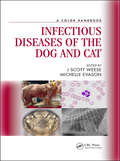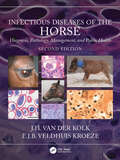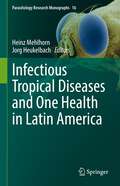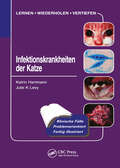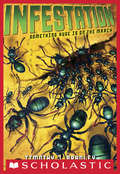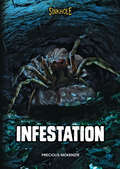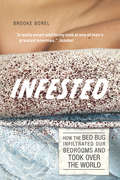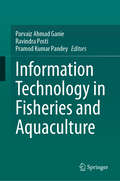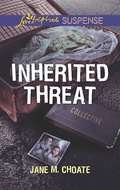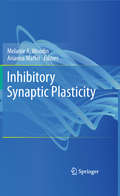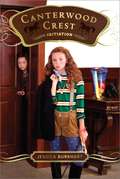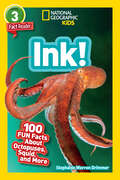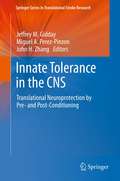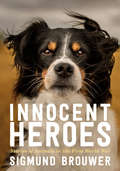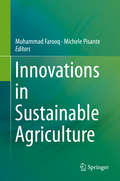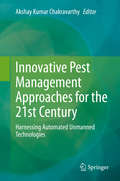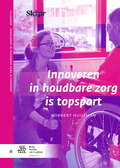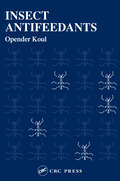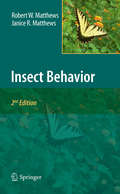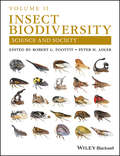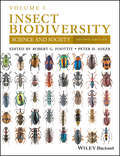- Table View
- List View
Infectious Diseases of the Dog and Cat: A Color Handbook
This is a concise and quick reference guide, clinically oriented, based on experience underpinned by published research data. The systems-based approach emphasizes the problem list process utilized by most practitioners when faced with a patient presenting with a single or variety of clinical symptoms. This allows generation of a complete list of infectious disease differentials, and the ability to include or exclude those indicated based on patient risk assessment. Pathogen specific information enables rational choice of diagnostics, therapy, and prognostication for a complete list of small animal infectious disease that includes bacterial, viral, parasitic/protozoal and fungal.
Infectious Diseases of the Horse: Diagnosis, pathology, management, and public health
by J.H. van der Kolk E.J.B. Veldhuis KroezeA clinician and a pathologist collaborate to create a comprehensive yet practical book about established infectious diseases of horses, categorised according to the different pathogens. The book evaluates the latest diagnostic aids, including rapid developments in molecular biology, while emphasising that they are no substitute for clinical observation and skills. The majority of equine infectious diseases caused by microbes and parasites are covered - bacterial, viral, protozoan, fungal, ectoparasitic and helminthic. Practical appendices contain a list of differential diagnoses based on clinical signs to support clinical decision-making, a list of zoonoses and reportable diseases, and an elaborate illustrated appendix on clinical pathology and haematology. Thoroughly updated a decade after the release of the original text, the book continues to be concise and easy to understand and remains an important resource for uncommon conditions. It adds new sections on pythiosis, equine encephalosis/Peruvian horse sickness virus, Acinetobacter baumanii, enteric coronavirus-induced disease, and viral hepatitis, as well as updated nomenclature according to the latest reference databases. The most dynamic changes in veterinary medicine concern the development of new molecular diagnostic techniques and therapies, and these have been updated with most recent references throughout this second edition. Finally, the exceptional, full-colour clinical and microscopic images are showcased in a larger format. Infectious Diseases of the Horse is a valuable resource for all veterinary practitioners, scientists, pathologists, students, technicians and nurses working with horses.
Infectious Tropical Diseases and One Health in Latin America (Parasitology Research Monographs #16)
by Heinz Mehlhorn Jorg HeukelbachThis book covers current aspects of important infectious diseases affecting human and animal health in Latin American countries. Readers are equipped with details on arthropod vectors as well as on neglected health problems. Diseases covered include Neglected Tropical Diseases such as Chagas Disease, schistosomiasis, tungiasis, myiasis and leishmaniasis, but also Zika and Chikungunya viral infections, plague and yellow fever. One focus is given on parasitic transmission routes.In addition, the authors describe current therapeutic options and sustainable control measures, considering both human and animal health. By highlighting options within the interdisciplinary One Health approach, they round off this work into a cutting-edge reference for diverse expert readers. Scientists and clinicians concerned on public health, entomology, tropical medicine and parasitology not only in Latin America will find this collection particularly valuable.Finally, these contributions are essential in the framework of the Sustainable Development Goals and the targets of SDG 3 (Good Health and Well-being) in order to combat and end epidemics of Neglected Tropical Diseases.
Infektionskrankheiten der Katze
by Katrin Hartmann Julie K. LevyDer erste in Deutsch erschienene Band aus der Reihe Veterinary Self-Assessment Colour Review behandelt alle Arten der Infektionskrankheiten der Katze. Er umfaßt Infektionen, die von Viren, Bakterien, Parasiten und Pilzen verursacht werden. Die 199 klinischen Fälle werden wie in der Praxis nach dem Zufallsprinzip präsentiert. Die breite Auswahl der Fälle sorgt dafür, daß alle Organsysteme der Katze vorkommen, die von Infektionen befallen werden. Die illustrierten klinischen Fallbeispiele enthalten in den Text integrierte Fragen und ausführlich erklärte Antworten. Das Buch wendet sich an Ärzte in Praxis und Klinik, an Studenten, HelferInnen und Techniker.
Infestation
by Timothy J. BradleyA contemporary take on the classic creature-feature genre. INFESTATION is a thrilling, fast-paced story that will leave your skin crawling. When Andy Greenwood is sent to the Reclamation School for Boys he expects the lousy food, mean drill sergeant instructors, and brutal bullies. What he doesn't expect is an infestation of weirdly large and aggressive ants, or the itching welts all over the staff and students. Even odder, Andy learns that kids never leave the school when they're supposed to. They just seem to get stuck there indefinitely. Following a ground-splitting earthquake, however, things quickly go from bad to horrifying. The school is overrun by monstrous bugs, and Andy himself comes face to face with mutant ants the size of humans, equipped with pinchers that can cut steel. Trapped in a cinderblock institutional building in the New Mexico desert, miles from civilization, Andy must figure out a way to save himself and the surviving boys from this nightmare.
Infestation (Sinkhole)
by Precious McKenzieIt was supposed to be a year to remember for seniors Sofia Schultz and Carmen Hernandez. But when weird things start happening around Foggy Creek, they quickly realize that it will be a memorable year—if they survive! Strange power surges, a missing cat, spooked horses, and mysterious tracks lead the friends to eerie sinkholes. There, they find giant tarantulas that will feed on everything they can get their hairy legs on. Can Sofia and Carmen stop the mutant creatures?
Infested: How the Bed Bug Infiltrated Our Bedrooms and Took Over the World
by Brooke BorelBed bugs. Few words strike such fear in the minds of travelers. In cities around the world, lurking beneath the plush blankets of otherwise pristine-looking hotel beds are tiny bloodthirsty beasts just waiting for weary wanderers to surrender to a vulnerable slumber. Though bed bugs today have infested the globe, the common bed bug is not a new pest at all. Indeed, as Brooke Borel reveals in this unusual history, this most-reviled species may date back over 250,000 years, wreaking havoc on our collective psyche while even inspiring art, literature, and music—in addition to vexatious red welts. In Infested, Borel introduces readers to the biological and cultural histories of these amazingly adaptive insects, and the myriad ways in which humans have responded to them. She travels to meet with scientists who are rearing bed bug colonies—even by feeding them with their own blood (ouch!)—and to the stages of musicals performed in honor of the pests. She explores the history of bed bugs and their apparent disappearance in the 1950s after the introduction of DDT, charting how current infestations have flourished in direct response to human chemical use as well as the ease of global travel. She also introduces us to the economics of bed bug infestations, from hotels to homes to office buildings, and the expansive industry that has arisen to combat them. Hiding during the day in the nooks and seams of mattresses, box springs, bed frames, headboards, dresser tables, wallpaper, or any clutter around a bed, bed bugs are thriving and eager for their next victim. By providing fascinating details on bed bug science and behavior as well as a captivating look into the lives of those devoted to researching or eradicating them, Infested is sure to inspire at least a nibble of respect for these tenacious creatures—while also ensuring that you will peek beneath the sheets with prickly apprehension.
Information Technology in Fisheries and Aquaculture
by Pramod Kumar Pandey Parvaiz Ahmad Ganie Ravindra PostiThis book connects information technology (IT) to the fisheries and aquaculture sectors. The topics covered in the book explore the diverse ways in which IT contributes to promoting sustainable practices and efficient management in aquatic environments. From examining current challenges through a technological lens to investigating advanced applications like Internet of Things (IoT), remote sensing and machine learning, the book covers a wide range of themes. The chapters address crucial aspects such as precision nutrition, disease management, environmental monitoring and the economic effects of adopting IT. It also bridges the gap between traditional aquaculture practices and the transformative potential of information technology. This book serves as a reference for researchers, practitioners, policymakers and students in the field of fisheries and aquaculture
Inherited Threat (Mills And Boon Love Inspired Suspense Ser.)
by Jane M. ChoateHazardous Legacy…Her mother’s mistakes have made her a target.After her estranged mother is killed by a crime syndicate, army ranger Laurel Landry knows she’s next…and she needs help from ex-ranger turned bodyguard Mace Ransom. While Mace is used to doing things his way, their best chance of staying alive is relying on each other. Their enemies aren’t backing down…but together Laurel and Mace might be able to stop them for good.
Inhibitory Synaptic Plasticity
by Arianna Maffei Melanie A. WoodinThis volume will explore the most recent findings on cellular mechanisms of inhibitory plasticity and its functional role in shaping neuronal circuits, their rewiring in response to experience, drug addiction and in neuropathology. Inhibitory Synaptic Plasticity will be of particular interest to neuroscientists and neurophysiologists.
Initiation
by Jessica BurkhartIt's time: The new girls are taking the spotlight at Canterwood Crest!Lauren has moved around enough to have the "new girl" code down:1. Lay low.2. But not too low.3. Don't amubush the in crowd.But Canterwood isn't just any school. And Lauren is about to face an initiation unlike any she's ever encountered. Bon chance, Lauren--you're going to need it!
Initiation
by Jessica BurkhartIt's time: The new girls are taking the spotlight at Canterwood Crest!Lauren has moved around enough to have the "new girl" code down:1. Lay low.2. But not too low.3. Don't amubush the in crowd.But Canterwood isn't just any school. And Lauren is about to face an initiation unlike any she's ever encountered. Bon chance, Lauren--you're going to need it!
Initiation
by Jessica BurkhartIt's time: The new girls are taking the spotlight at Canterwood Crest!Lauren has moved around enough to have the "new girl" code down:1. Lay low.2. But not too low.3. Don't amubush the in crowd.But Canterwood isn't just any school. And Lauren is about to face an initiation unlike any she's ever encountered. Bon chance, Lauren--you're going to need it!
Ink!: 100 Fun Facts About Octopuses, Squid, and More (Readers)
by Stephanie Warren DrimmerMeet cuttlefish that can camouflage themselves, octopuses that outsmart their predators, and squid that patrol the deep in this cool fact-filled reader.Learn everything you've ever wanted to know about cephalopods, from inking, to hunting, to coconut carrying. Squish along with squid, camouflage with cuttlefish, and marvel at magnificent octopuses. Packed with weird-but-true facts and tons of cool animal info, this Level 3 Reader explores the incredible world of cephalopods. National Geographic Fact Readers feature the same expert-vetted running text as traditional readers--with a bonus of 100 fun facts sprinkled throughout! A fact roundup at the end of each book lets kids review what they've learned. (Plus, they can impress their friends with their animal expertise!)
Inky: The Seeing Eye Dog
by Elizabeth P. HeppnerMore than anything in the world, Jonathan wants a dog. Then he finds a frisky puppy in the woods. But Inky already has an owner--the Seeing Eye. Jonathan is crushed until the man who has come for Inky asks, "Jonathan, how would you like to take care of Inky for the next twelve months?"
Innate Tolerance in the CNS
by John H. Zhang Miguel A. Perez-Pinzon Jeffrey M. GiddayCerebral preconditioning is a phenomenon wherein a mild insult or stress induces cellular and tissue adaptation or tolerance to a later, severe injury, therefore reflecting the efficacy of endogenous mechanisms of cerebrovascular protection. Initially identified for rapid cardiac protection, preconditioning has expanded to all aspects of CNS protection from ischemia, trauma and potentially neurodegeneration. Many different stimuli or stressors have been identified as preconditioning agents, suggesting a downstream convergence of mechanisms and underscoring the potential for translational application of preconditioning in the clinic. Moreover, the fundamental mechanisms responsible for preconditioning-induced tolerance will help in the design novel pharmacological approaches for neuroprotection. While stroke and many other brain injuries are not predictable, in some populations (e.g., metabolic syndrome, patients undergoing carotid endarterectomy, aneurysm clipping, or with recent TIAs) the risk for stroke is identifiable and significant, and preconditioning may represent a useful strategy for neuroprotection. For unpredictable injuries, post-conditioning the brain - or inducing endogenous protective mechanisms after the initial injury - can also abrogate the extent of injury. Finally, remote pre- and post-conditioning methods have been developed in animals, and are now being tested in clinical trials, wherein a brief, noninjurious stress to a noncerebral tissue (i.e., skeletal muscle) can provide protection to the CNS and thereby allows clinicians the opportunity to circumvent concerns regarding the direct preconditioning of neurological tissues.
Innocent Heroes: Stories of animals in the First World War
by Sigmund BrouwerA unique celebration of the important role animals play in war, and an insightful look at the taking of Vimy Ridge from the perspective of 3 men in a Canadian platoon.Never before have the stories of animal war heroes been collected in such a special way. This book consists of eight connected fictional stories about a Canadian platoon in WW1. The Storming Normans have help from some very memorable animals: we meet a dog who warns soldiers in the trench of a gas attack, a donkey whose stubbornness saves the day, a cat who saves soldiers from rat bites, and many more. Each story is followed by nonfiction sections that tell the true story of these animals from around the world and of the Canadian soldiers who took Vimy Ridge. Through the friendship that grows between three of these soldiers in particular, we get a close-up look at life in the trenches, the taking of Vimy Ridge, the bonds between soldiers and their animals and what it meant to be Canadian in WW1.From the Hardcover edition.
Innovations in Sustainable Agriculture
by Muhammad Farooq Michele PisanteThis volume is a ready reference on sustainable agriculture and reinforce the understanding for its utilization to develop environmentally sustainable and profitable food production systems. It describes ecological sustainability of farming systems, present innovations for improving efficiency in the use of resources for sustainable agriculture and propose technological options and new areas of research in this very important area of agriculture.
Innovative Pest Management Approaches for the 21st Century: Harnessing Automated Unmanned Technologies
by Akshay Kumar ChakravarthySeveral Integrated Pest Management (IPM) approaches are available for managing pests of varied kinds, including individual and integrated methods for pest suppression. Recently the focus has shifted to pest management tools that act on insect systems selectively, are compatible with the environment, and are not harmful for ecosystems. Other approaches target specific biochemical and physiological aspects of insect metabolism, and involve biotechnological and genetic manipulation. Still other approaches include the use of nanotechnology, endophytes, optical and sonic manipulation to detect and control pest insects. Unfortunately, conventional forms of pest management do not focus on technology transfer to the ground level workers and farmers. As a result, farmers are incurring huge losses of crops and revenues. This book highlights the importance of using communication tools in pest management and demonstrates some success stories of utilizing automated unmanned technologies in this context. The content is divided into three sections, the first of which, “Pest Population Monitoring: Modern Tools,” covers long and short-range pest population monitoring techniques and tools such as satellites, unmanned aerial vehicles/drones, remote sensing, digital tools like GIS, GPS for mapping, lidar, mobile apps, software systems, artificial diet designs and functional diversity of info-chemicals. The second section of the book is devoted to “Emerging Areas in Pest Management” and offers a glimpse of diversified tactics that have been developed to contain and suppress pest populations such as endophytes, insect vectors of phytoplasma, Hymenopterans parasitoids, mass production and utilization of NPV etc. In turn, the third section focuses on “Integrated Pest Management” and presents farming situations that illustrate how research in diversified aspects has helped to find solutions to specific pest problems, and how some new and evolving tactics can be practically implemented. Given its scope, the book offers a valuable asset for entomology and plant pathology researchers, students of zoology and plant protection, and readers whose work involves agriculture, horticulture, forestry and other ecosystems.
Innoveren in houdbare zorg is topsport
by Robbert Huijsmanhet boek bevat een slectie van weblogs van de hand van Robbert Huijsman over het anders en slimmer organiseren van de zorg. Eerder gepubliceerd op Skipr.nl in periode 2009-2013.
Insect Antifeedants
by Opender KoulDependence upon neurotoxic chemicals as a means to control pest insects has lead to several problems: environmental hazards associated with broad-spectrum pesticides, negative impacts on non-target organisms such as natural enemies and pollinators, and the development of resistance to these chemicals among target species. Researchers have sought al
Insect Behavior
by Janice R. Matthews Robert W. MatthewsThis book offers a comprehensive overview of fundamental concepts of animal behavior as they relate to insects. Considerably updated and expanded, this new edition includes 26 case studies, as well as 45 new color plates and 173 figures (over 40% of them new) with detailed legends that add richness to the well-written, accessible text.
Insect Biodiversity: Science and Society
by Peter H. Adler Robert G. FoottitVolume Two of the new guide to the study of biodiversity in insects Volume Two of Insect Biodiversity: Science and Society presents an entirely new, companion volume of a comprehensive resource for the most current research on the influence insects have on humankind and on our endangered environment. With contributions from leading researchers and scholars on the topic, the text explores relevant topics including biodiversity in different habitats and regions, taxonomic groups, and perspectives. Volume Two offers coverage of insect biodiversity in regional settings, such as the Arctic and Asia, and in particular habitats including crops, caves, and islands. The authors also include information on historical, cultural, technical, and climatic perspectives of insect biodiversity. This book explores the wide variety of insect species and their evolutionary relationships. Case studies offer assessments on how insect biodiversity can help meet the needs of a rapidly expanding human population, and examine the consequences that an increased loss of insect species will have on the world. This important text: Offers the most up-to-date information on the important topic of insect biodiversity Explores vital topics such as the impact on insect biodiversity through habitat loss and degradation and climate change With its companion Volume I, presents current information on the biodiversity of all insect orders Contains reviews of insect biodiversity in culture and art, in the fossil record, and in agricultural systems Includes scientific approaches and methods for the study of insect biodiversity The book offers scientists, academics, professionals, and students a guide for a better understanding of the biology and ecology of insects, highlighting the need to sustainably manage ecosystems in an ever-changing global environment.
Insect Biodiversity: Science and Society, Volume 1
by Peter H. Adler Robert G. FoottitVolume One of the thoroughly revised and updated guide to the study of biodiversity in insects The second edition of Insect Biodiversity: Science and Society brings together in one comprehensive text contributions from leading scientific experts to assess the influence insects have on humankind and the earth’s fragile ecosystems. Revised and updated, this new edition includes information on the number of substantial changes to entomology and the study of biodiversity. It includes current research on insect groups, classification, regional diversity, and a wide range of concepts and developing methodologies. The authors examine why insect biodiversity matters and how the rapid evolution of insects is affecting us all. This book explores the wide variety of insect species and their evolutionary relationships. Case studies offer assessments on how insect biodiversity can help meet the needs of a rapidly expanding human population, and also examine the consequences that an increased loss of insect species will have on the world. This important text: Explores the rapidly increasing influence on systematics of genomics and next-generation sequencing Includes developments in the use of DNA barcoding in insect systematics and in the broader study of insect biodiversity, including the detection of cryptic species Discusses the advances in information science that influence the increased capability to gather, manipulate, and analyze biodiversity information Comprises scholarly contributions from leading scientists in the field Insect Biodiversity: Science and Society highlights the rapid growth of insect biodiversity research and includes an expanded treatment of the topic that addresses the major insect groups, the zoogeographic regions of biodiversity, and the scope of systematics approaches for handling biodiversity data.
